When Jim Homet decided to rescue Tiki one logistic problem was - no trailer. Tiki was in Branford, CT and her new home was going to be in Portsmouth, New Hampshire. This is the story of Tiki's trailer.
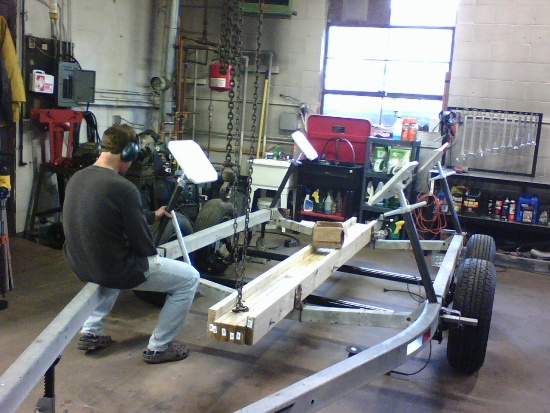
This is the trailer being built/modified in Jim's friend's shop.
This are Jim's emails and pictures of this trailer are consolidated below (minor edits)
Hi Ron
Tiki is home and safe.
I think she was a little bit more than my Ranger was designed for, but she made it without a problem. The guys with the travel lift in Branford weighed the hull in at 5,000 without mast, sails or interior. I have trailered my 3000# catboat quite a bit in New England with a single axle trailer. I was concerned about having a tire blow out with Tiki's expected weight so we converted Tiki's trailer to a tandem. She tracks beautifully. The boat sits with about 200# - 300# on the tongue, and most of the weight on the keel. The stands are tight, but I think they are only giving lateral support to her.
The trailer is a 1999 21' Easy Loader that used to have rollers on it. I looked at their website, and couldn't even guess what the model # was. The trailer rails are 3" wide by 4" high. The rails are a standard 72" wide. The trailer length is 21' 6" including the coupler.
I bought it from a guy in Maine for $250. I ordered a tandem axle kit with a 4" drop axle and ultra lube spindles for, I think, $460 delivered from ABC trailer parts. I bought a new coupler and light kit for about $60 more. The stands came from Hostar down in Wareham, MA, and were $45 for the pad, screw and handle assembly. The tubes were sold for $3 a foot, and the angle iron was from a lumber yard. The tires were off of other trailers, and the trailer is now in the yard on blocks. The pressure treated 2 x 4's and 2 x 6's came to about $30.
I'd say total investment in the trailer was right over $1,000.
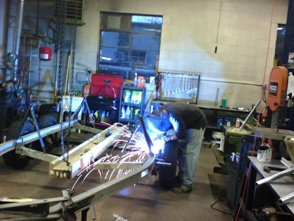 |
I trailered to my friend's shop on a Monday morning around 9, and we finished about twelve hours later. The keel supports that I added (the four 2x4's sandwiched between two 2x6's) proved to be too narrow. The idea was sound, and I would do it again only wider this time. Otherwise everything worked well. The center of the axles is 54.25" from the rear of the trailer. The drop axles really brought the height of the trailer down. I never used this trailer to haul anything heavy so I don't have any comparison, but I believe the lower center of gravity makes the trailer much more stable. |
|
The boat sits on the trailer nearly perfectly with the full keel supported, and the rudder free. I pulled this from Connecticut with my Ford Ranger. There was definitely weight on the tongue of the trailer, but the Ranger only dipped about an inch or so when the travel lift set Tiki down. |
The boat sits on the trailer nearly perfectly with the full keel supported, and the rudder free. I pulled this from Connecticut with my Ford Ranger. There was definitely weight on the tongue of the trailer, but the Ranger only dipped about an inch or so when the travel lift set Tiki down.
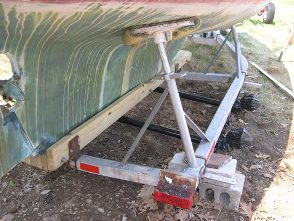 |
I wanted the weight of the boat to be supported by keel boards, and jack stands to provide lateral support. I sandwiched four 2x4's between two 2x6's to make the keel board. My thinking was that the 2x6's would stand proud of the 2x4's and provide a guide for the keel as well as some lateral resistance.
I ended up having to cut the outside 2x6's flush with the 2x4's at the yard as the keel was wider than I thought. I like the design though, and I think it supports the keel well. The wood is bolted together using threaded rod, and then held to the frame with angle iron and u-bolts.
|
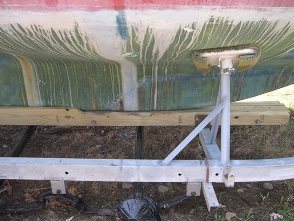 |
The front stands are 89" from the rear of the trailer. The tube holding the stand screw is 19" tall (but should be 15"). The stand is fully depressed. The bottom of the tube is 35" from the centerline of the trailer, and the top of the tube 28" from the centerline.
The stand and tubing are from Hostar, and the angle iron was whatever was on hand. There is a hole drilled in the frame rail in the center of where the tube lies to allow any water that gets in to drain out. The stands are well supported, but the forward base should be about 2-3" lower.
|
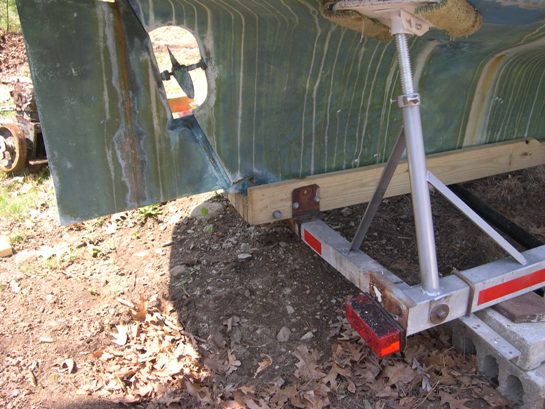
The back stands are 20" tall with 6" of screw showing. I think this stand is just about right. I believe the stand will be able to be depressed at the bottom of the ramp which should allow the boat to float free when launching or retrieving.
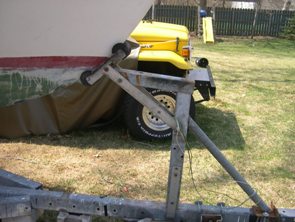 |
The bow support was cobbled together from whatever was at hand, but it seems to work well. There are two rollers attached to the stand by a single bolt. That bolt allows the rollers to adjust to the bow. That bolt is 207" from the rear of the trailer and is 32" high as measured from the frame rail. |
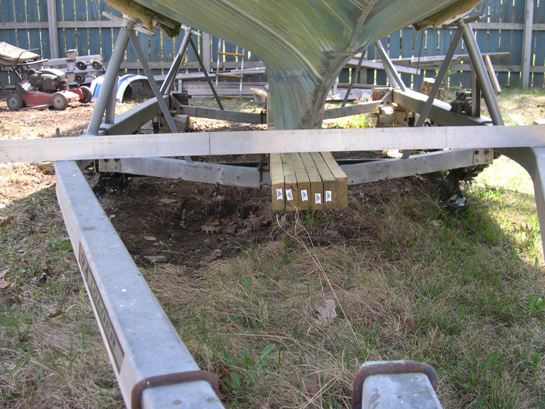
This is a straight edge run from rail to rail to demonstrate the height of the keel boards. The top of the keelboards is approx. 3" below the level of the rails.
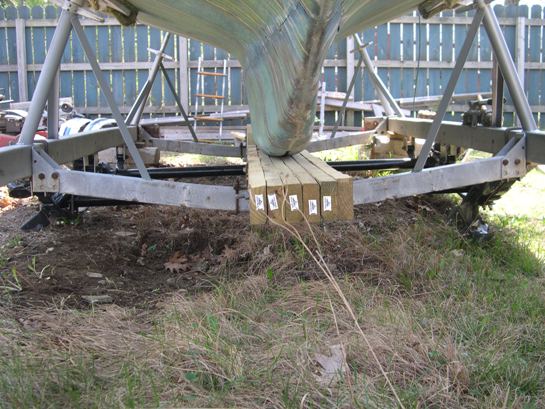
****************************
|
|
